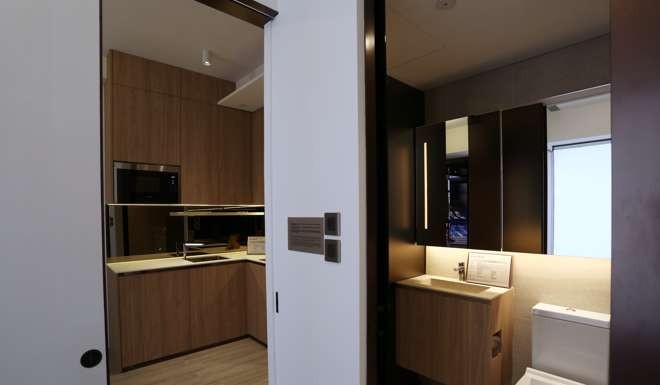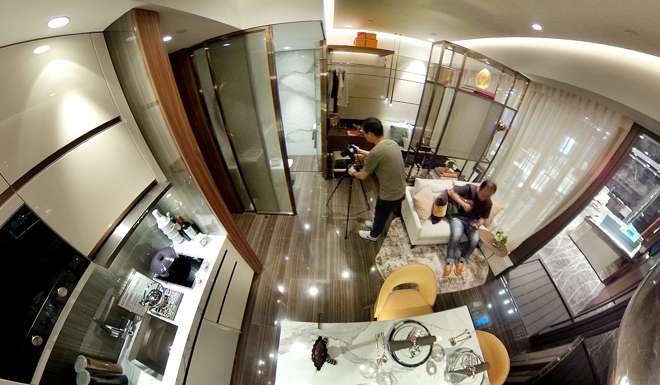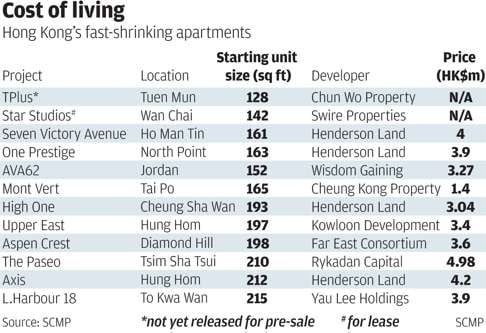
Hong Kong homes shrink as prices soar, and affordability goes out the window
In the past 12 months, new records were set with every project launch, as developers aim for first-time buyers who’ve basically given up hope of affording decent-size apartments
What does it feel like to live in 50 square feet, less than half the space of a parking lot?
That will be on offer at Chun Wo Property Development TPlus apartments in Tuen Mun, which will set the Hong Kong record -- and quite possibly a world first-- for Lilliputian-size apartments when they are completed in September 2018.
Sizes start from 128 sq ft in the 356-unit complex. After deducting the space set aside for a balcony, a toilet and an open kitchen, the owner will be left with 50 sq ft of living space, according to JLL’s managing director and head of capital market Joseph Tsang. Each of the 52 parking lots in the complex, at 134 square feet, will be larger than the apartment itself.
“It is tiny, but it’s hard to tell if there won’t be even smaller projects in future,” he said.
Apartments in Hong Kong, already the world’s least affordable major city when measured in per-square-foot price, are shrinking fast as prices keep soaring.
In the past 12 months, new records were set with every project launch, as developers aim for first-time buyers who’ve basically given up hope of affording larger apartments. Better own a shoebox, than rent a decent-size apartment forever, the thinking goes.

“History tells us that when developers or owners rush to launch mini properties, regardless of whether they are flats, office or shop units, that’s sending out a message that capital is drying up,” Tsang said. “Simply put, there are fewer buyers out there with the money” to afford apartments of decent, normal sizes, he said.
Investors buy shoebox apartments to rent out to fresh graduates or new-to-town job seekers who’re striking out on their own.
“Most of them are looking for 100-plus sq ft units and are willing to prepay two years’ rents in one go,” said Edward Yiu Chung-yim, associate professor at the Chinese University’s department of geography and resource management. “The rental yield for flats around universities could reach as high as 6 to 7 per cent per year.”
The re-sale value of these properties, especially those located away from Hong Kong’s business or commercial districts, are limited because it’s hard to find buyers willing to use them as permanent homes.
Hong Kong’s average apartment prices stand at a record 19 times gross median income, according to a January survey by US-based Demographia, which defines any region with median multiple higher than 5.1 as “severely unaffordable.”
Anybody seeking to buy a decent-size home in Hong Kong isn’t left with very many options, since prices have outpaced income growth and soared beyond the reach of average earners, Yiu said.
“Those keen to buy a home now are left with three choices: buy small, buy old, or buy far away from the city centre,” he said.
The Hong Kong government’s 2013 move to double the stamp duty on second-home buyers, followed by a standard rate of 15 per cent in November ostensibly to cap prices and cool the market, also pushed demand toward the smaller end, as the tax burden decreases with size.
“Developers are gradually shifting to build small apartments to meet growing demand,” Yiu said. “Once they spotted the bread that sells best,, they will bake them.”

In October, Emperor International Holdings took the crown temporarily with plans to convert a 21-storey commercial building in Happy Valley into a 68-unit apartment complex. Each of the units will measure about 200 sq ft, inclusive of an open kitchen and bathroom, with a net living area of 61.4 sq ft.
Also in October, Swire Properties released its newly renovated residential building Star Studios, with units start from 142 sq ft, for lease.
The price growth of small apartments have outpaced other categories of residential property, rising 8.7 per cent in the first 10 months of 2016, the Rating & Valuation Department’s data showed.
Vincent Cheung Kiu-cho, executive director of valuation and advisory services for Asia at Colliers International said demand by first-home buyers are spurring developers to build small flats.
“The small-sized units can yield a higher unit price,” he said.

A 165 sq ft unit at Mont Vert in Tai Po changed hands for HK$2.3 million, or HK$13,939 per square foot, early in August, according to the Land Registry’s data. The buyer, who bought it for HK$1.4 million in 2014, earned a gross profit of HK$910,000 from the sale. It’s rented out for HK$6,500 per month.
Hong Kong home prices - jumped 159 per cent since 2008 - began to fall after reaching peak in September last year but bounced back to near record levels last month.
Tsang said the current mortgage rules was another catalyst for building small flats, especially those that cost less than HK$4 million each because only they are eligible for up to 90 per cent loans under current mortgage rules.
The trend, also encouraged by the government which put size restrictions on sites sold from 2011 to 2015 to increase home supply, has further aggravated Hong Kong’s dearth of livable space.
“T Plus is aimed at helping young people own homes,” said Anthony Poon Chi-choi, director of Chun Wo, a unit of Hong Kong-listed Asia Allied Infrastructure Holdings. “Young people stay in their bedrooms after meals. What they need is just a room.”
What sells may not necessarily be what’s healthy though, said the Chinese University’s Yiu.
“People who face different stress factors or family disputes can make tight living conditions a problem,” he said.

